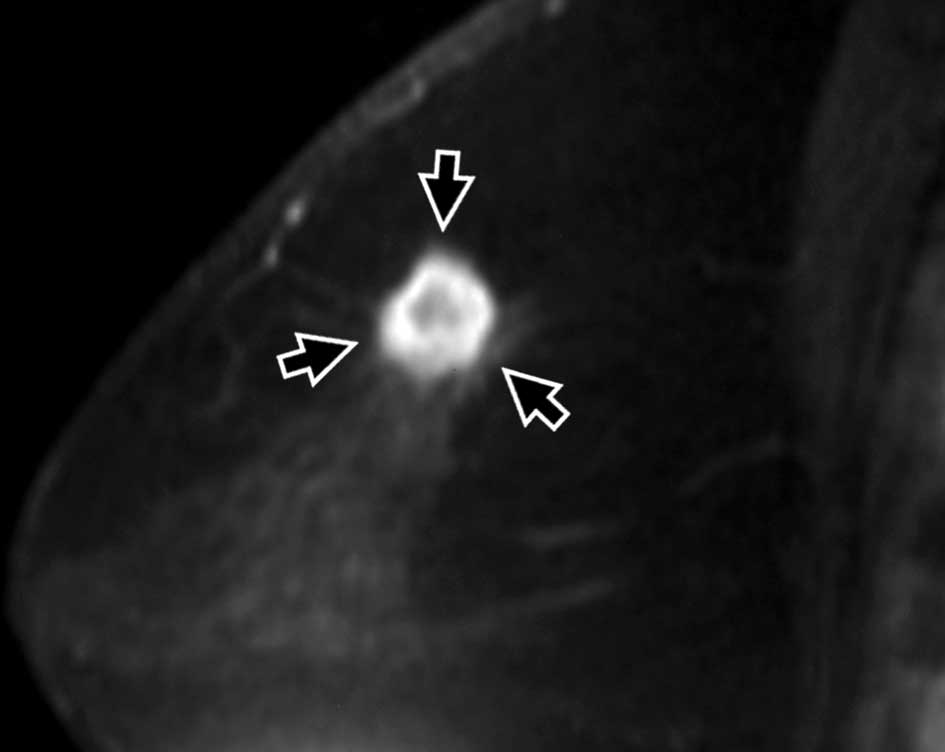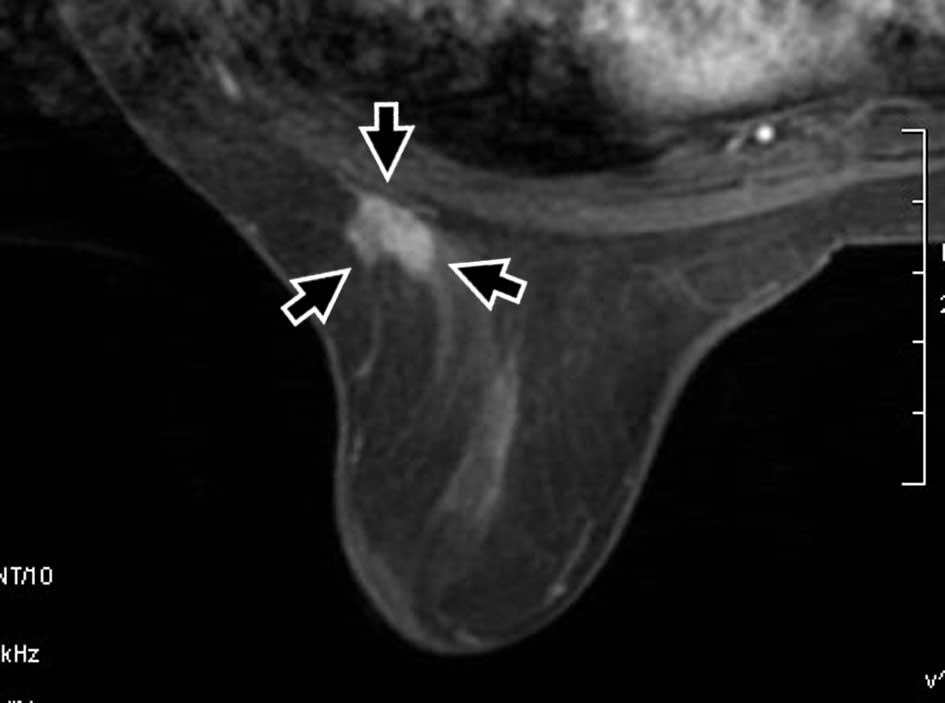|
1.
|
Sonoo H and Noguchi S: Results of
questionnaire survey on breast cancer surgery in Japan 2004–2006.
Breast Cancer. 15:3–4. 2008.
|
|
2.
|
Veronesi U, Cascinelli N, Mariani L, Greco
M, Saccozzi R, Luini A, Aguilar M and Marubini E: Twenty-year
follow-up of a randomized study comparing breast-conserving surgery
with radical mastectomy for early breast cancer. N Engl J Med.
347:1227–1232. 2002.PubMed/NCBI
|
|
3.
|
Schmitz AC, Gianfelice D, Daniel BL, Mali
WP and van den Bosch MA: Image-guided focused ultrasound ablation
of breast cancer: current status, challenges, and future
directions. Eur Radiol. 18:1431–1441. 2008. View Article : Google Scholar : PubMed/NCBI
|
|
4.
|
Jolesz FA: MRI-guided focused ultrasound
surgery. Annu Rev Med. 60:417–430. 2009. View Article : Google Scholar
|
|
5.
|
Manenti G, Bolacchi F, Perretta T, Cossu
E, Pistolese CA, Buonomo OC, Bonanno E, Orlandi A and Simonetti G:
Small breast cancers: in vivo percutaneous US-guided radiofrequency
ablation with dedicated cool-tip radiofrequency system. Radiology.
251:339–346. 2009. View Article : Google Scholar : PubMed/NCBI
|
|
6.
|
Kinoshita T, Iwamoto E, Tsuda H and Seki
K: Radiofrequency ablation as local therapy for early breast
carcinomas. Breast Cancer. Jan 14–2010.(E-pub ahead of print).
|
|
7.
|
Littrup PJ, Jallad B, Chandiwala-Mody P,
D'Agostini M, Adam BA and Bouwman D: Cryotherapy for breast cancer:
a feasibility study without excision. J Vasc Interv Radiol.
20:1329–1341. 2009. View Article : Google Scholar : PubMed/NCBI
|
|
8.
|
Ogawa Y, Kubota K, Ue H, Kataoka Y,
Tadokoro M, Miyatake K, Tsuzuki K, Yamanishi T, Itoh S, Hitomi J,
Hamada N, Kariya S, Fukumoto M, Nishioka A and Inomata T: Phase I
study of a new radiosensitizer containing hydrogen peroxide and
sodium hyaluronate for topical tumor injection: a new
enzyme-targeting radiosensitization treatment, Kochi
Oxydol-Radiation Therapy for Unresectable Carcinomas, Type II
(KORTUC II). Int J Oncol. 34:609–618. 2009. View Article : Google Scholar
|
|
9.
|
Ogawa Y, Kubota K, Ue H, et al:
Development and clinical application of a new radiosensitizer
containing hydrogen peroxide and hyaluronic acid sodium for topical
tumor injection – a new enzyme-targeting radiosensitization
treatment, KORTUC II (Kochi Oxydol-Radiation Therapy for
Unresectable Carcinomas Type II). Strahlenther Onkol. 183:100–101.
2007.PubMed/NCBI
|
|
10.
|
UICC. TNM Classification of Malignant
Tumors. 6th edition. Wiley-Liss; New York: pp. 2002
|
|
11.
|
Goldhirsch A, Wood WC, Gelber RD, Coates
AS, Thürlimann B and Senn HJ: 10th St. Gallen conference. Progress
and promise: highlights of the international expert consensus on
the primary therapy of early breast cancer 2007. Ann Oncol.
18:1133–1144. 2007. View Article : Google Scholar : PubMed/NCBI
|
|
12.
|
Therasse P, Arbuck SG, Eisenhauer EA,
Wanders J, Kaplan RS, Rubinstein L, Verweij J, van Glabbeke M, van
Oosterom AT, Christian MC and Gwyther SG: New guidelines to
evaluate the response to treatment in solid tumors. European
Organization for Research and Treatment of Cancer, National Cancer
Institute of the United States, National Cancer Institute of
Canada. J Natl Cancer Inst. 92:205–216. 2000. View Article : Google Scholar
|
|
13.
|
Tatsumi M, Cohade C, Mourtzikos KA,
Fishman EK and Wahl RL: Initial experience with FDG-PET/CT in the
evaluation of breast cancer. Eur J Nucl Med Mol Imaging.
33:254–262. 2006. View Article : Google Scholar : PubMed/NCBI
|
|
14.
|
Halsted WS: The results of operations for
the cure of cancer of the breast performed at the Johns Hopkins
Hospital from June, 1889, to January, 1894. Ann Surg. 20:497–555.
1984. View Article : Google Scholar : PubMed/NCBI
|
|
15.
|
Fisher B, Jeong JH, Anderson S, Bryant J,
Fisher ER and Wolmark N: Twenty-five-year follow-up of a randomized
trial comparing radical mastectomy, total mastectomy, and total
mastectomy followed by irradiation. N Engl J Med. 347:567–575.
2002.PubMed/NCBI
|
|
16.
|
Fisher B, Anderson S, Bryant J, Margolese
RG, Deutsch M, Fisher ER, Jeong JH and Wolmark N: Twenty-year
follow-up of a randomized trial comparing total mastectomy,
lumpectomy, and lumpectomy plus irradiation for the treatment of
invasive breast cancer. N Engl J Med. 347:1233–1241.
2002.PubMed/NCBI
|
|
17.
|
Ogawa Y, Nishioka A, Inomata T, Ohnishi T,
Kariya S, Terashima M, Yoshida S, Tohchika N, Tanaka Y and Kumon M:
Conservation treatment intensified with an anti-estrogen agent and
CAF chemotherapy for stage I and II breast cancer. Oncol Rep.
7:479–484. 2000.PubMed/NCBI
|
|
18.
|
Ogawa Y, Nishioka A, Inomata T, Yokota N,
Sasaki T, Terashima M, Yoshida S, Tanaka Y and Tohchika N:
Conservation treatment intensified with tamoxifen and CAF
chemotherapy without axillary dissection for early breast cancer
patients with clinically-negative axillary nodes. Oncol Rep.
6:801–805. 1999.
|
|
19.
|
Ogawa Y, Takahashi T, Kobayashi T, Kariya
S, Nishioka A, Mizobuchi H, Noguchi M, Hamasato S, Tani T, Seguchi
H, Yoshida S and Sonobe H: Mechanism of apoptotic resistance of
human osteosarcoma cell line, HS-Os-1, against irradiation. Int J
Mol Med. 12:453–458. 2003.PubMed/NCBI
|
|
20.
|
Ogawa Y, Takahashi T, Kobayashi T, Kariya
S, Nishioka A, Ohnishi T, Saibara T, Hamasato S, Tani T, Seguchi H,
Yoshida S and Sonobe H: Apoptotic-resistance of the human
osteosarcoma cell line HS-Os-1 to irradiation is converted to
apoptotic-susceptibility by hydrogen peroxide: a potent role of
hydrogen peroxide as a new radiosensitizer. Int J Mol Med.
12:845–850. 2003.PubMed/NCBI
|
|
21.
|
Ogawa Y, Takahashi T, Kobayashi T, Kariya
S, Nishioka A, Hamasato S, Moriki T, Seguchi H, Yoshida S and
Sonobe H: Immunocytochemical characteristics of human osteosarcoma
cell line HS-Os-1: possible implication in apoptotic resistance
against irradiation. Int J Mol Med. 14:397–403. 2004.
|
|
22.
|
Ogawa Y, Ue H, Tsuzuki K, Tadokoro M,
Miyatake K, Sasaki T, Yokota N, Hamada N, Kariya S, Hitomi J,
Nishioka A, Nakajima K, Ikeda M, Sano S and Inomata T: New
radiosensitization treatment (KORTUC I) using hydrogen peroxide
solution-soaked gauze bolus for unresectable and superficially
exposed neoplasms. Oncol Rep. 19:1389–1394. 2008.
|
|
23.
|
Chasin WD, Gross CC, Wang CC and Miller D:
Hydrogen peroxide and irradiation of tumors. Arch Otolaryngol.
85:151–155. 1967. View Article : Google Scholar : PubMed/NCBI
|
|
24.
|
Bianchini G, Salgarello G, Mennini T and
Lorini G: Intra-arterial infusion of hydrogen peroxide in
radiotherapy of malignant tumors. Radiol Med. 55:207–225.
1969.PubMed/NCBI
|
|
25.
|
Coates AS, Keshaviah A, Thurlimann B, et
al: Five years of letrozole compared with tamoxifen as initial
adjuvant therapy for postmenopausal women with endocrine-responsive
early breast cancer: update of study BIG 1–98. J Clin Oncol.
25:486–492. 2007.PubMed/NCBI
|
|
26.
|
Fisher B, Brown AM, Dimitrov NV, et al:
Two months of doxorubicin-cyclophosphamide with and without
interval reinduction therapy compared with 6 months of
cyclophosphamide, methotrexate, and fluorouracil in positive-node
breast cancer patients with tamoxifen-nonresponsive tumors: results
from the National Surgical Adjuvant Breast and Bowel Project B-15.
J Clin Oncol. 8:1483–1496. 1990.
|
|
27.
|
Fisher B, Anderson S, Tan-Chiu E, Wolmark
N, Wickerham DL, Fisher ER, Dimitrov NV, Atkins JN, Abramson N,
Merajver S, Romond EH, Kardinal CG, Shibata HR, Margolese RG and
Farrar WB: Tamoxifen and chemotherapy for axillary node-negative,
estrogen receptor-negative breast cancer: findings from National
Surgical Adjuvant Breast and Bowel Project B-23. J Clin Oncol.
19:931–942. 2001.
|
|
28.
|
Jansen SJ, Otten W and Stiggelbout AM:
Review of determinants of patients' preferences for adjuvant
therapy in cancer. J Clin Oncol. 22:3181–3190. 2004.
|
|
29.
|
Esserman L, Hylton N, George T and Weidner
N: Contrast-enhanced magnetic resonance imaging to assess tumor
histopathology and angiogenesis in breast carcinoma. Breast J.
5:13–21. 1999. View Article : Google Scholar : PubMed/NCBI
|
|
30.
|
Esserman L, Hylton N, Yassa L, Barclay J,
Frankel S and Sickles E: Utility of magnetic resonance imaging in
the management of breast cancer: evidence for improved preoperative
staging. J Clin Oncol. 171:110–119. 1999.PubMed/NCBI
|
|
31.
|
Tsuboi N, Ogawa Y, Inomata T, Yoshida D,
Yoshida S, Moriki T and Kumon M: Changes in the findings of dynamic
MRI by preoperative CAF chemotherapy for patients with breast
cancer of stage II and III: Pathologic correlation. Oncol Rep.
6:727–732. 1999.PubMed/NCBI
|
|
32.
|
Kubota K, Ogawa Y, Nishioka A, Kariya S,
Itoh S, Murata Y, Hamada N, Maeda H and Tanaka Y: Diagnostic
accuracy of mammography, ultrasonography and magnetic resonance
imaging in the detection of intraductal spread of breast cancer
following neoadjuvant chemotherapy. Oncol Rep. 17:915–918.
2007.
|
|
33.
|
Nakamura S, Kenjo H, Nishi T, Kazama T,
Doi O and Suzuki K: Efficacy of 3D-MR mammography for breast
conserving surgery after neoadjuvant chemotherapy. Breast Cancer.
9:15–19. 2002. View Article : Google Scholar : PubMed/NCBI
|
|
34.
|
Leconte I, Feger C, Galant C, Berliere M,
Berg BV, D'Hoore W and Maldague B: Mammography and subsequent
whole-breast sonography of nonpalpable breast cancers: the
importance of radiologic breast density. AJR. 180:1675–1679. 2003.
View Article : Google Scholar : PubMed/NCBI
|
|
35.
|
Yang WT, Lam WW, Cheung H, Suen M, King WW
and Metreweli C: Sonographic, magnetic resonance imaging, and
mammographic assessments of preoperative size of breast cancer. J
Ultrasound Med. 16:791–797. 1997.PubMed/NCBI
|
|
36.
|
Berg WA, Gutierrez L, NessAiver MS, Carter
WB, Bhargavan M, Lewis RS and Ioffe OB: Diagnostic accuracy of
mammography, clinical examination, US, and MR imaging in
preoperative assessment of breast cancer. Radiology. 233:830–849.
2004. View Article : Google Scholar : PubMed/NCBI
|
|
37.
|
Adler LP, Crowe JP, Al-Kaisi NH and
Sunshine JL: Evaluation of breast masses and axillary lymph nodes
with [F-18] 2-deoxy-2-fluoro-D-glucose PET. Radiology. 187:743–750.
1993.
|
|
38.
|
Avril N, Dose J, Jänicke F, Bense S,
Ziegler S, Laubenbacher C, Römer W, Pache H, Herz M, Allgayer B,
Nathrath W, Graeff H and Schwaiger M: Metabolic characterization of
breast tumors with positron emission tomography using F-18
fluorodeoxyglucose. J Clin Oncol. 14:1848–1857. 1996.PubMed/NCBI
|
|
39.
|
Hata T, Takahashi H, Watanabe K, Takahashi
M, Taguchi K, Itoh T and Todo S: Magnetic resonance imaging for
preoperative evaluation of breast cancer: a comparative study with
mammography and ultrasonography. J Am Coll Surg. 198:190–197. 2004.
View Article : Google Scholar : PubMed/NCBI
|
|
40.
|
Van Goethem M, Schelfout K, Dijckmans L,
van Der Auwera C, Weyler J, Verslegers I, Biltjes I and De Schepper
A: MR mammography in the pre-operative staging of breast cancer in
patients with dense breast tissue: comparison with mammography and
ultrasound. Eur Radiol. 14:809–816. 2004.PubMed/NCBI
|
|
41.
|
Gottlober P, Kerscher MJ, Korting HC and
Peter RU: Sonographic determination of cutaneous and subcutaneous
fibrosis after accidental exposure to ionising radiation in the
course of the Chernobyl nuclear power plant accident. Ultrasound
Med Biol. 14:9–13. 1997. View Article : Google Scholar
|
|
42.
|
Adams MJ, Lipshultz SE, Schwartz C,
Fajardo LF, Coen V and Constine LS: Radiation-associated
cardiovascular disease: manifestations and management. Semin Radiat
Oncol. 13:346–356. 2003. View Article : Google Scholar : PubMed/NCBI
|
|
43.
|
Jones JP and Leeman S: Ultrasonic tissue
characterization. Acta Electronica. 26:3–31. 1984.
|
|
44.
|
Baz E, Madjar H, Reuss C, Vetter M,
Hackeloer B and Holz K: The role of enhanced Doppler ultrasound in
differentiation of benign vs. malignant scar lesion after breast
surgery for malignancy. Ultrasound Obstet Gynecol. 15:377–382.
2000. View Article : Google Scholar : PubMed/NCBI
|
















